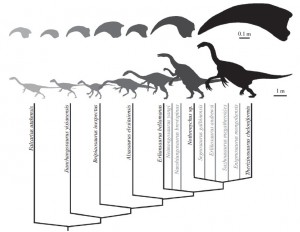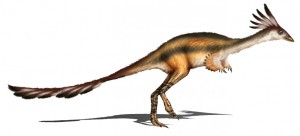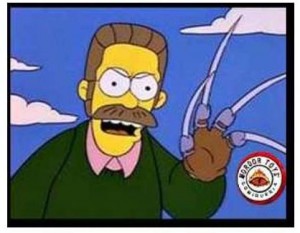Therizinosaurs were some of the true freaks of the dinosaur world. I mean that in the nicest possible way for something that looked like the sick offspring of a giant chicken and Freddie Kruger. Perhaps the weirdest things about them were these long, scythe-like claws, that although may have seemed deadly, probably weren’t unless you were a particularly scrummy looking piece of foliage. That’s right, these cousins of tyrannosaurs and other theropods used their wicked sickle-claws for trimming hedges for food.
But how diverse were the claws of these evolutionary oddities, and what does this imply for how they were used? In palaeontology and ecology, we have hypothetical links between form and function – that is, how does the shape and size of a particular aspect of an animal help it to perform a role better. There are now so many cool ways of looking at this, from biomechanical modelling using CT-scanning to analysis of shape using geometric morphometrics.
I’m not as late as usual to the latest in this, but again, it’s the team from Bristol in the UK doing some pretty cool stuff with this. Previously, it has been suggested that these claws, some times over half a metre in length, were used for probing insect colonies for noms, sexual display (claws are sexy?), climbing trees sort of like a sloth, stripping bark from trees, or harvesting vegetation like the old days in mid-western USA – these guys were pretty much the dinosaurian ranch farmers of their time.
To figure out exactly what function therizinosaur claws had, Stephan Lautenschlager used a shape analysis known as Fourier transformation (FT), combined with a mechanical test known as finite-element analysis (FEA), on 65 different theropod species – the group to which therizinosaurs belong and including all the other meat-eating dinos. To draw links to what role the claws might play, he compared these with the claws of a range of extant (living) mammals where the function was known in advance from observation.

Diversity in therizinosaur claws! (source)
To perform the comparative analyses, a multivariate ordination technique known as principal components analysis was used. This method of dimension reduction takes the shape of the claws after they have been transformed into a set of geometric co-ordinates, and plots them according to a number new variables that attempt to explain the maximum amount of variation in the dataset. In this case, the first ‘principal component’ only explained 27% of the variance, with the second only explaining about 18%. Usually, this is pretty inadequate and implies that the new variables aren’t sufficiently capturing the true variation of your original variables (the differences in the claw shapes) – usually the threshold is around 95% of the variance explained by x-number of principal components, each requiring further investigation, not just the first two as they’re easy to plot on a nice graph..
Irrespective of this, most of the change mapped by the analyses described elongation of the claws, but when theropods are analysed alone, a portion of the variance describes a change in their curvature. Interestingly, different theropod groups don’t map out in different ‘spaces’ in the graphs, suggesting broad shape convergence in all groups about the mean shape of all claws analysed. One exception are a group called Alvarezsauridae, which were a weird little bunch, which occupied their own distinct region of this ‘morphospace’ – a two-dimensional area describing the shape variation for each group. This group actually overlaps with one group of mammals that have a peculiar burrowing mode of life, suggesting that perhaps alvarezsaurids were the same..? Importantly, therizinosaurs, the weird Grim Reaper-like dinos, occupied the broadest morphospace of all groups, suggesting a high diversity in shapes. The FEA results compliment this finding rather nicely, suggesting a high diversity in claw functions, which show overlaps with mammals that lived in trees, or simply lived on the ground or in burrows. This was mostly for therizinosaurs with shorter more compact claws, whereas longer and curvier claws might have been used for a more digging scenario when foraging, or a mode of life not found in mammals.

Alvarezsaurus, with its teeny little claws! (source)
A commonly depicted scenario is that therizinosaurs would use their scythe-claws as a defence mechanism against any happy-go-lucky predators. However, Lautenschlager actually found little evidence that the claws could be used in this fashion, and perhaps the large body size of these beasties was enough of a deterrent. Instead, what this study highlights is that even with cutting edge techniques, in can be still very difficult to try and figure out exactly how animals behaved in the past, and what their weird adaptations might have been used for.
What it does show, however, is that again dinosaurs were more evolutionary diverse and specialised than previously thought, occupying a range of ecologies much broader than modern mammals. Evolutionary failures still, anyone?
More from Lautenschlager: https://blogs.egu.eu/network/palaeoblog/2013/11/19/three-dimensions-of-palaeontological-awesomeness/
Reference: Lautenschlager, S. (2014) Morphological and functional diversity in therizinosaur claws and the implications for theropod claw evolution, Proceedings of the Royal Society B, 281 (link)


Pingback: Grim reaper or gentle giants? | Green Tea and V...
Gary Fields
What a great article. I just completed a life size Therizinosaurus hand claw and forearm. You can see it on my Facebook page Paleo Art Lab. Let me know what you think!
Pingback: Morsels For The Mind – 13/06/2014 › Six Incredible Things Before Breakfast